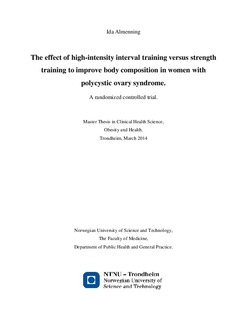The Effect of High-Intensity Interval Training Versus Strength Training to Improve Body Composition in Women With Polycystic Ovary Syndrome - A Randomized Controlled Trial
Master thesis
Permanent lenke
http://hdl.handle.net/11250/281452Utgivelsesdato
2014Metadata
Vis full innførselSamlinger
Sammendrag
Background: Polycystic ovary syndrome (PCOS) is a common endocrine disorder affecting 6-20% of reproductive-age women. Women with PCOS tend to accumulate more upper body fat,
and the syndrome is often present with abdominal obesity and visceral adiposity which is further
associated with metabolic – and cardiovascular complications. Despite well-established benefits
of exercise and its recommendation in PCOS management, few randomized controlled trials have
evaluated the benefits of exercise as the only intervention on body composition in women with
PCOS. Objective: The aim of the present study was to investigate the effect of high-intensity
interval training (HIT) and strength training (ST) versus control, on body composition in women
with PCOS. Methods: We did a randomized controlled trial, including 31 previously sedentary
women randomly assigned to one of three groups; High intensity interval training (HIT; n = 10),
strength training (ST; n = 11) and control (CG; n = 10). At baseline and 10 weeks follow-up,
body composition and anthropometrics was evaluated and compared between groups. Outcome
measures: Body composition and visceral fat (VF), body weight, and waist circumference (WC).
Results: Twenty-five women completed the study intervention and post-training testing (ST;
n=8, HIT; n=8 and CG; n=9). Weight did not change in any group. There was a significant
decrease in percentage fat mass (FM) after ST [EMM: -1.6, 95% CI: -2.5 to -0.7] and HIT [EMM:
-0.9, 95% CI: -2.2 to -0.0], respectively. Fat-free mass (FFM) increased significantly after ST
[EMM: 1.2, 95% CI: 0.4 – 2.1], but not after HIT [EMM: 0.4, 95% CI: -0.2 to 1.1]. There was
no significant between-group differences in the change in percentage FM (p=0.54) and FFM
(p=0.18). There was no changes in WC or VF within or between groups. Conclusion: These data
indicates that in the absence of body weight changes, both ST and HIT have beneficial effect on
body composition in women with PCOS. Percentage FM decreased significantly after both ST
and HIT, and FFM increased significantly after ST.
Utgiver
NTNUBeslektede innførsler
Viser innførsler beslektet ved tittel, forfatter og emneord.
-
European Training Manual for Transferable Skills in SET Disciplines. Training the mindSET – Improving and Internationalizing Skills Trainings for Doctoral Candidates
Lietzmann, Anja; Kiehne, Björn; Burhoff, Daniela Kleine; Steinmann, Sinje; Aliverti, Andrea; Beffani, Armando; Biscari, Paolo; Buganza, Tommaso; Carson, Siri Granum; Gladysz, Bartlomiej; Glodzinski, Eryk; Gustafsson, Hana; Jarzebowska, Elzbieta; Jaskanis, Adrianna; Kalis, Peer-Olaf; Kratzer, Jan; Lenschow, Harald; Lohmann, Renate; Lyng, Reidar; Malicka, Edyta; Marszalec, Janusz; Medbø, Eirik Gjelsvik; Nikol, Petra; Perner, Susanne; Schiaffonati, Viola; Schulz, Alexandra; Szymborski, Mateusz; Welker, Bertram; Widding, Øystein; Vigtil, Astrid (Research report, 2021) -
Effects of one long vs. two short resistance training sessions on training volume and affective responses in resistance-trained women
Pedersen, Helene; Sæterbakken, Atle Hole; Fimland, Marius Steiro; Iversen, Vegard Moe; Schoenfeld, Brad J; Stien, Nicolay; Andersen, Vidar (Peer reviewed; Journal article, 2022)The aim of this study was to compare the acute effects of performing a lower body resistance training program in one long or two shorter sessions in 1 day on training volume and affective measures. Employing a randomized-crossover ... -
High-Intensive Interval Training or Supramaximal Interval Training - What to Choose When the Goal is to Improve VO2max and Aerobic Endurance Performance in Females
Bård Vegard Ytrehauge Balto (Master thesis, 2019)Aim: The present study aims to compare the effects of high-intensive interval training (HIIT) and all-out supramaximal intensity interval training (SIT) on maximal oxygen uptake (VO2max), work economy (WE), lactate threshold ...
